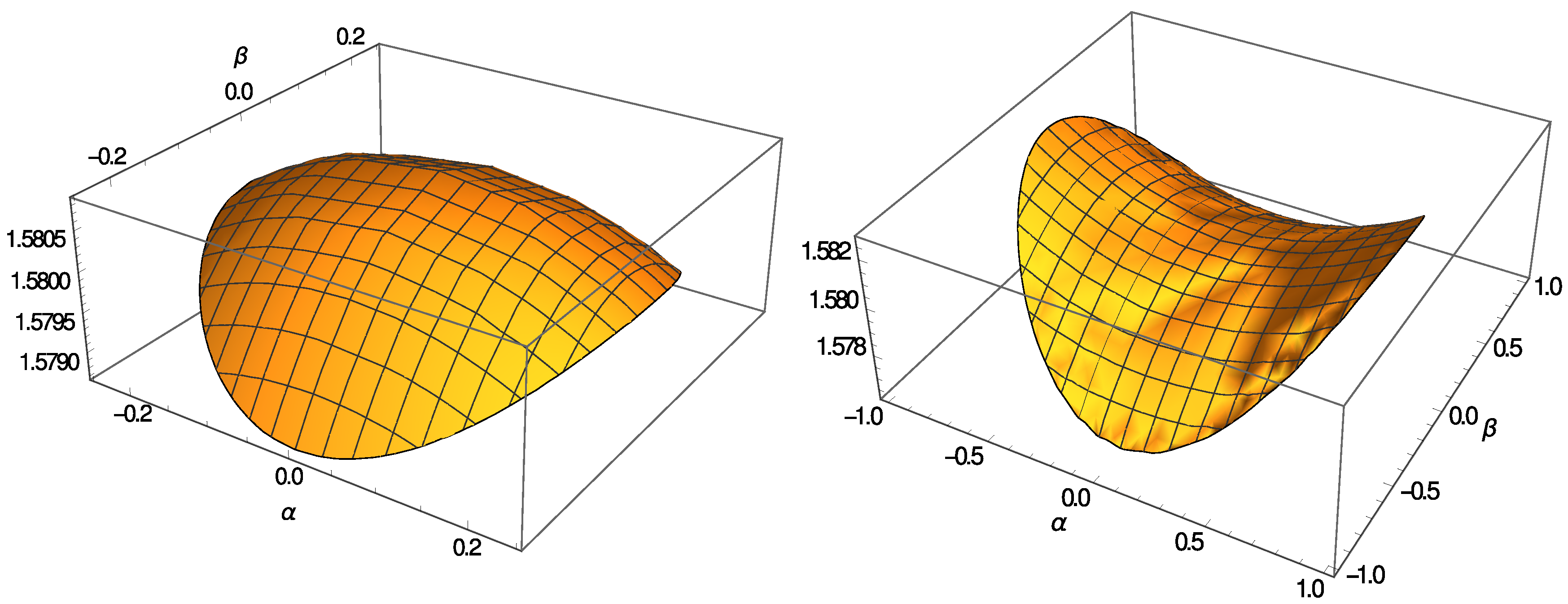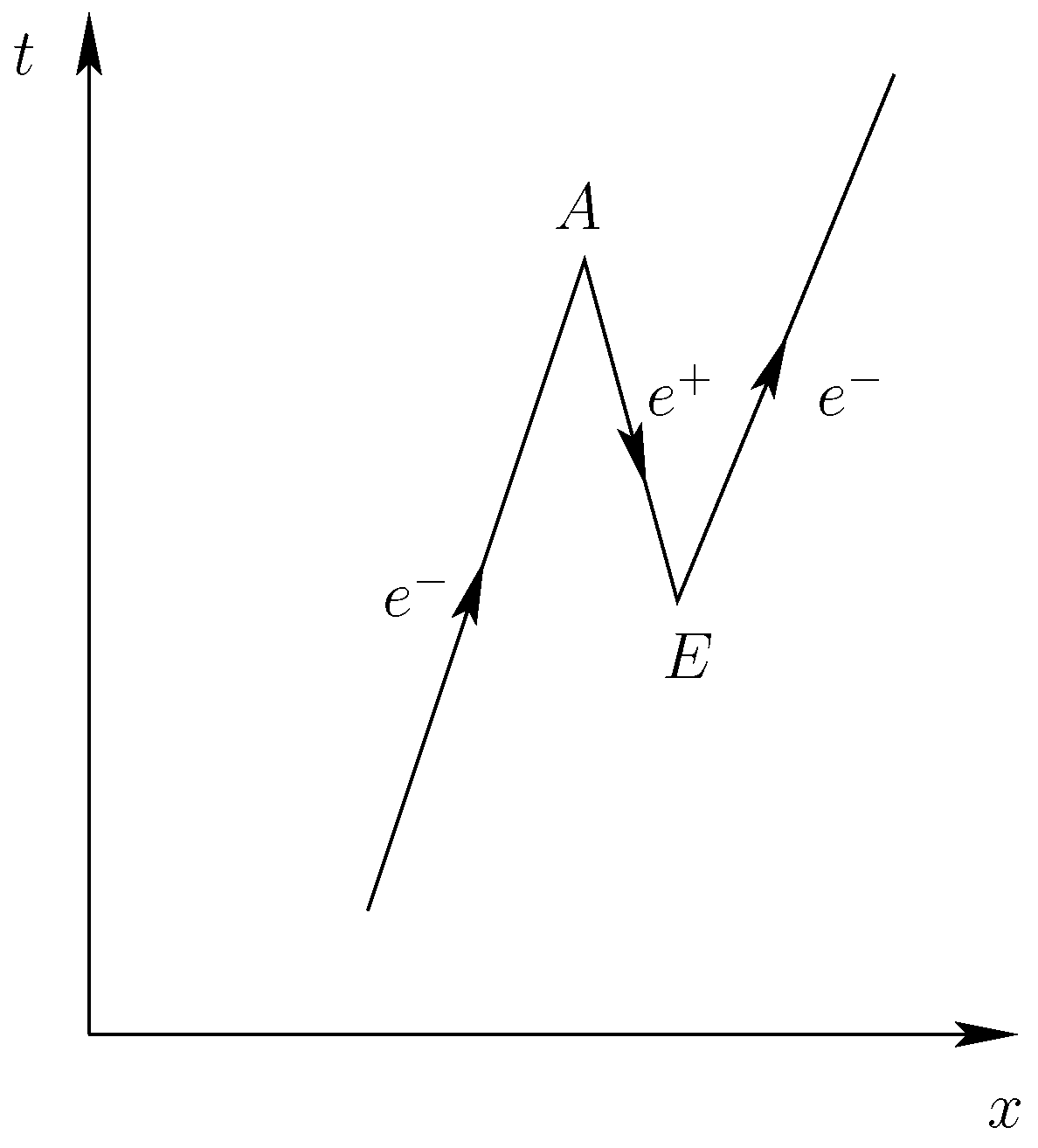Stationary Schrödinger Equation and Darwin Term from Maximal Entropy Random Walk
Abstract
:1. Introduction
2. Method
3. Applications of MERW
3.1. Free Motion in a Box
3.2. Motion in a Potential
4. Excited States
5. Conclusions
- MERW treats stationary states of a diffusion process resulting from the eigenvalue Equation (3) of the step matrix M. These states can be represented by rays in a Hilbert space.
- MERW distinguishes between amplitudes and probabilities . The amplitudes count the number of trajectories arriving in the equilibrium distribution at a certain position. The probabilities indicate the share of trajectories, which, in the equilibrium distribution, pass at x. They are not modified by the Markov process.
- MERW respects the Born rule. It derives this rule from the relation (11) between the step matrix M and the stochastic matrix S, and the request that S leaves a probability distribution invariant. MERW impressively shows how the Born rule appears from a measurement between an equilibrium state in the past and the same equilibrium state in the future. This symmetry of the evolution from past to present, and to the evolution from present to future, was already investigated by Erwin Schrödinger in his article [19] on the reversal of the laws of nature. The translation of this article is available in [29].
- With the appropriate choice of the diffusion constant (25), MERW derives the Schrödinger equation for a free particle.
- Generalising the observation that time in a gravitational field is running in different heights with a different speed to arbitrary potentials, MERW respects the rule that all trajectories of same duration are counted with equal probability. In this way, MERW allows us to derive the Schrödinger equation for a particle in a potential.
- From diffusion, MERW derives both the stationary Schrödinger equation and the Darwin term of the nonrelativistic expansion of the Dirac equation.
- MERW is a diffusion process which propagates in the reduced Compton time a distance of n of reduced Compton wave lengths . The width of the ground state of the atomic hydrogen may indicate as a realistic order of magnitude. MERW does not explain the mechanism driving this diffusion process. The pair creation with a necessary energy of around 1 MeV may not be the origin of the Darwin term. After observing that in elastic scattering processes the position of the particles is not conserved, the author is rather inclined to think of some yet unknown scattering processes. In this respect, Ref. [2] argues in favour of a zero-point field.
- The kinetic term in Equation (41) is of a statistical origin only. The velocity seems to correspond to the diffusive velocity, as defined in [2] p. 125. In MERW, there is no “classical” kinetic energy, which is characteristic for the classical motion in Bohr’s model of the hydrogen atom. In this sense, MERW cannot describe states with a non-vanishing angular momentum or oscillations in a classical potential. Such excited states appear in MERW as metastable states only, in distinction to the Schrödinger equation, where these states are stable.
- Amplitudes are numbers of trajectories and should be positive. This is true in the state with the highest entropy, corresponding to the ground state. Amplitudes for states with lower entropy have nodes and therefore regions with negative amplitudes. Trajectories traversing the nodes in opposite directions cancel and thus never cross the nodes. The particle–antiparticle picture has to be introduced to explain these cancellations.
- MERW can explain the subtraction of trajectory numbers by a particle–antiparticle picture only. Therefore, the explanation of interference in Young’s double slit experiment remains very questionable.
- MERW does not explain the violation of Bell’s theorem, as quantum mechanics nicely does.
Funding
Data Availability Statement
Acknowledgments
Conflicts of Interest
Appendix A. Entropy for Markov Processes


References
- Griffiths, D.; Schroeter, D. Introduction to Quantum Mechanics; Cambridge University Press: Cambridge, UK, 2018. [Google Scholar]
- de la Peña, L.; Cetto, A.; Valdes-Hernandez, A. The Emerging Quantum: The Physics Behind Quantum Mechanics; Springer: Cham, Switherland, 2014; p. 366. [Google Scholar]
- Cook, D.B. Schrödinger’s Mechanics: Interpretation; World Scientific (Europe): London, UK, 2018; p. 196. Available online: https://www.worldscientific.com/doi/pdf/10.1142/q0143 (accessed on 6 April 2023). [CrossRef]
- Ralston, J. How to Understand Quantum Mechanics; IOP Concise Physics; Morgan & Claypool Publishers: Williston, VT, USA, 2018. [Google Scholar] [CrossRef]
- Dong, S.H. Factorization Method in Quantum Mechanics; Fundamental Theories of Physics: Springer; Dordrecht, The Netherland, 2007. [Google Scholar]
- Couder, Y.; Fort, E.; Gautier, C.H.; Boudaoud, A. From Bouncing to Floating: Noncoalescence of Drops on a Fluid Bath. Phys. Rev. Lett. 2005, 94, 177801. [Google Scholar] [CrossRef] [PubMed]
- Komech, A.I. Lectures on Quantum Mechanics and Attractors; World Scientific: Hackensack, NJ, USA; London, UK; Singapore; Beijing, China; Shanghai, China; Hong Kong; Taipei, Taiwan; Chennai, India; Tokyo, Japan, 2022; p. 272. Available online: https://www.worldscientific.com/doi/pdf/10.1142/12602 (accessed on 6 April 2023). [CrossRef]
- Burda, Z.; Duda, J.; Luck, J.M.; Waclaw, B. Localization of the Maximal Entropy Random Walk. Phys. Rev. Lett. 2009, 102, 160602. [Google Scholar] [CrossRef] [PubMed]
- Sinatra, R.; Gómez-Gardeñes, J.; Lambiotte, R.; Nicosia, V.; Latora, V. Maximal-entropy random walks in complex networks with limited information. Phys. Rev. E 2011, 83, 030103. [Google Scholar] [CrossRef] [PubMed]
- Ochab, J.K. Maximal-entropy random walk unifies centrality measures. Phys. Rev. E 2012, 86, 066109. [Google Scholar] [CrossRef] [PubMed]
- Ochab, J.K.; Burda, Z. Maximal entropy random walk in community detection. Pthe Eur. Phys. J. Spec. Top. 2013, 216, 81. [Google Scholar] [CrossRef]
- Duda, J. Optimal encoding on discrete lattice with translational invariant constrains using statistical algorithms. arXiv 2007, arXiv:0710.3861. [Google Scholar]
- Duda, J. Diffusion models for atomic scale electron currents in semiconductor, p-n junction. arXiv 2021, arXiv:2112.12557. [Google Scholar]
- Duda, J. Four-dimensional understanding of quantum mechanics and Bell violation. arXiv 2009, arXiv:0910.2724. [Google Scholar]
- Darwin, C.G. The Wave Equations of the Electron. Proc. R. Soc. London. Ser. Contain. Pap. Math. Phys. Character 1928, 118, 654–680. [Google Scholar]
- Sakurai, J. Advanced Quantum Mechanics; Always learning, Pearson Education, Incorporated: London, UK, 2006. [Google Scholar]
- Jaynes, E.T. Information Theory and Statistical Mechanics. Phys. Rev. 1957, 106, 620–630. [Google Scholar] [CrossRef]
- Beller, M. Quantum Dialogue: The Making of a Revolution; University of Chicago Press: Chicago, IL, USA, 1999. [Google Scholar]
- Schrödinger, E. Über die Umkehrung der Naturgesetze. Sitz. Ber. Preuss. Akad. Wissen. Berlin Phys. Math. 1931, 8 N9, 144–153. [Google Scholar]
- Chou, C.W.; Hume, D.B.; Rosenband, T.; Wineland, D.J. Optical Clocks and Relativity. Science 2010, 329, 1630–1633. [Google Scholar] [CrossRef] [PubMed]
- Faber, M. Energy as a measure for the elapse of time. arXiv 2018, arXiv:1810.13239. [Google Scholar] [CrossRef]
- Schulman, L. Techniques and Applications of Path Integration; Wiley: Hoboken, NJ, USA, 1996. [Google Scholar]
- Thaller, B. The Nonrelativistic Limit. In The Dirac Equation; Springer: Berlin/Heidelberg, Germany, 1992; pp. 176–192. [Google Scholar] [CrossRef]
- Chen, T.W.; Chiou, D.W. Correspondence between classical and Dirac-Pauli spinors in view of the Foldy-Wouthuysen transformation. Phys. Rev. 2014, 89. [Google Scholar] [CrossRef]
- Schrödinger, E. Quantisierung als Eigenwertproblem (Erste Mitteilung). Ann. Der Phys. 1926, 79, 361–376. [Google Scholar] [CrossRef]
- Abele, H.; Jenke, T.; Leeb, H.; Schmiedmayer, J. Ramsey’s Method of Separated Oscillating Fields and Its Application to Gravitationally Induced Quantum Phase Shifts. Phys. Rev. D 2010, 81, 065019. [Google Scholar] [CrossRef]
- Suda, M.; Faber, M.; Bosina, J.; Jenke, T.; Käding, C.; Micko, J.; Pitschmann, M.; Abele, H. Spectra of neutron wave functions in Earth’s gravitational field. Z. FüR Naturforschung 2022, 77, 875–898. [Google Scholar] [CrossRef]
- Faber, M. From Soft Dirac Monopoles to the Dirac Equation. Universe 2022, 8, 387. [Google Scholar] [CrossRef]
- Muratore-Ginanneschi, P.; Schwieger, K.E. Schrödinger’s 1931 paper “On the Reversal of the Laws of Nature” [Über die Umkehrung der Naturgesetze”, Sitzungsberichte der preussischen Akademie der Wissenschaften, physikalisch-mathematische Klasse, 8 N9 144–153]. Eur. Phys. J. 2021, 46, 28. [Google Scholar] [CrossRef]
- David Mermin, N. What’s Wrong with this Pillow? Phys. Today 1989, 42, 9–11. [Google Scholar] [CrossRef]
- Eddington, A.S. The Nature of the Physical World, Chapter X, The New Quantum Theory; Cambridge University Press: Cambridge, UK, 1928; pp. 201–229. [Google Scholar]
- Schrödinger, E. Sur la Theórie relativistie de l’electron et l’interpretation de la mechanique quantique. Ann. Inst. H. Poincaré 1932, 2, 269–310. [Google Scholar]
- Bernstein, S. Sur les liaisons entre les grandeurs aléatoires. Verhandlungen Des Int. Math. 1932, 1.Band, 288–309. [Google Scholar]
- Yasue, K. Quantum mechanics and stochastic control theory. J. Math. Phys. 1981, 22, 1010–1020. [Google Scholar] [CrossRef]
- Zambrini, J.C. Stochastic mechanics according to E. Schrödinger. Phys. Rev. A 1986, 33, 1532–1548. [Google Scholar] [CrossRef] [PubMed]
- Zambrini, J.C. Variational processes and stochastic versions of mechanics. J. Math. Phys. 1986, 27, 2307–2330. [Google Scholar] [CrossRef]
- Zambrini, J. Euclidean quantum mechanics. Phys. Rev. 1987, 35, 3631. [Google Scholar] [CrossRef]


Disclaimer/Publisher’s Note: The statements, opinions and data contained in all publications are solely those of the individual author(s) and contributor(s) and not of MDPI and/or the editor(s). MDPI and/or the editor(s) disclaim responsibility for any injury to people or property resulting from any ideas, methods, instructions or products referred to in the content. |
© 2023 by the author. Licensee MDPI, Basel, Switzerland. This article is an open access article distributed under the terms and conditions of the Creative Commons Attribution (CC BY) license (https://creativecommons.org/licenses/by/4.0/).
Share and Cite
Faber, M. Stationary Schrödinger Equation and Darwin Term from Maximal Entropy Random Walk. Particles 2024, 7, 25-39. https://doi.org/10.3390/particles7010002
Faber M. Stationary Schrödinger Equation and Darwin Term from Maximal Entropy Random Walk. Particles. 2024; 7(1):25-39. https://doi.org/10.3390/particles7010002
Chicago/Turabian StyleFaber, Manfried. 2024. "Stationary Schrödinger Equation and Darwin Term from Maximal Entropy Random Walk" Particles 7, no. 1: 25-39. https://doi.org/10.3390/particles7010002
APA StyleFaber, M. (2024). Stationary Schrödinger Equation and Darwin Term from Maximal Entropy Random Walk. Particles, 7(1), 25-39. https://doi.org/10.3390/particles7010002





